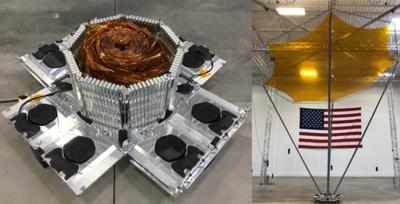Mon, Feb 04, 2019
RF Risk Reduction Deployment Demonstration Targeted For Launch In Late February
DARPA’s Radio Frequency Risk Reduction Deployment Demonstration (R3D2) is set for launch in late February to space-qualify a new type of membrane reflectarray antenna. The antenna, made of a tissue-thin Kapton membrane, packs tightly for stowage during launch and then will deploy to its full size of 7.5 feet in diameter once it reaches low Earth orbit.

R3D2 will monitor antenna deployment dynamics, survivability and radio frequency (RF) characteristics of a membrane antenna in low-Earth orbit. The antenna could enable multiple missions that currently require large satellites, to include high data rate communications to disadvantaged users on the ground. A successful demonstration also will help prove out a smaller, faster-to-launch and lower cost capability, allowing the Department of Defense, as well as other users, to make the most of the new commercial market for small, inexpensive launch vehicles. Satellite design, development, and launch took approximately 18 months.
“The Department of Defense has prioritized rapid acquisition of small satellite and launch capabilities. By relying on commercial acquisition practices, DARPA streamlined the R3D2 mission from conception through launch services acquisition,” said Fred Kennedy, director of DARPA’s Tactical Technology Office. “This mission could help validate emerging concepts for a resilient sensor and data transport layer in low Earth orbit – a capability that does not exist today, but one which could revolutionize global communications by laying the groundwork for a space-based internet.”
The launch will take place on a Rocket Lab USA Electron rocket from the company’s launch complex on the Mahia Peninsula of New Zealand. Northrop Grumman is the prime contractor and integrated the satellite; MMA Design designed and built the antenna. Trident Systems designed and built R3D2’s software-defined radio, while Blue Canyon Technologies provided the spacecraft bus.
(Image provided wit DARPA news release: MMA Design successfully completes deployment testing of its innovative high-compaction ratio reflectarray antenna in its Louisville, Colorado facilities)
More News
Light Gun A handheld directional light signaling device which emits a brilliant narrow beam of white, green, or red light as selected by the tower controller. The color and type of>[...]
"The journey to this achievement started nearly a decade ago when a freshly commissioned Gentry, driven by a fascination with new technologies and a desire to contribute significan>[...]
Aero Linx: JAARS, Inc. For decades now, we’ve landed planes on narrow rivers and towering mountains. We’ve outfitted boats and vehicles to reach villages that rarely se>[...]
"Our driven and innovative team of military and civilian Airmen delivers combat power daily, ensuring our nation is ready today and tomorrow." Source: General Duke Richardson, AFMC>[...]
Aircraft Conflict Predicted conflict, within EDST of two aircraft, or between aircraft and airspace. A Red alert is used for conflicts when the predicted minimum separation is 5 na>[...]
 ANN's Daily Aero-Term (04.20.24): Light Gun
ANN's Daily Aero-Term (04.20.24): Light Gun Aero-News: Quote of the Day (04.20.24)
Aero-News: Quote of the Day (04.20.24) ANN's Daily Aero-Linx (04.21.24)
ANN's Daily Aero-Linx (04.21.24) Aero-News: Quote of the Day (04.21.24)
Aero-News: Quote of the Day (04.21.24) ANN's Daily Aero-Term (04.21.24): Aircraft Conflict
ANN's Daily Aero-Term (04.21.24): Aircraft Conflict



